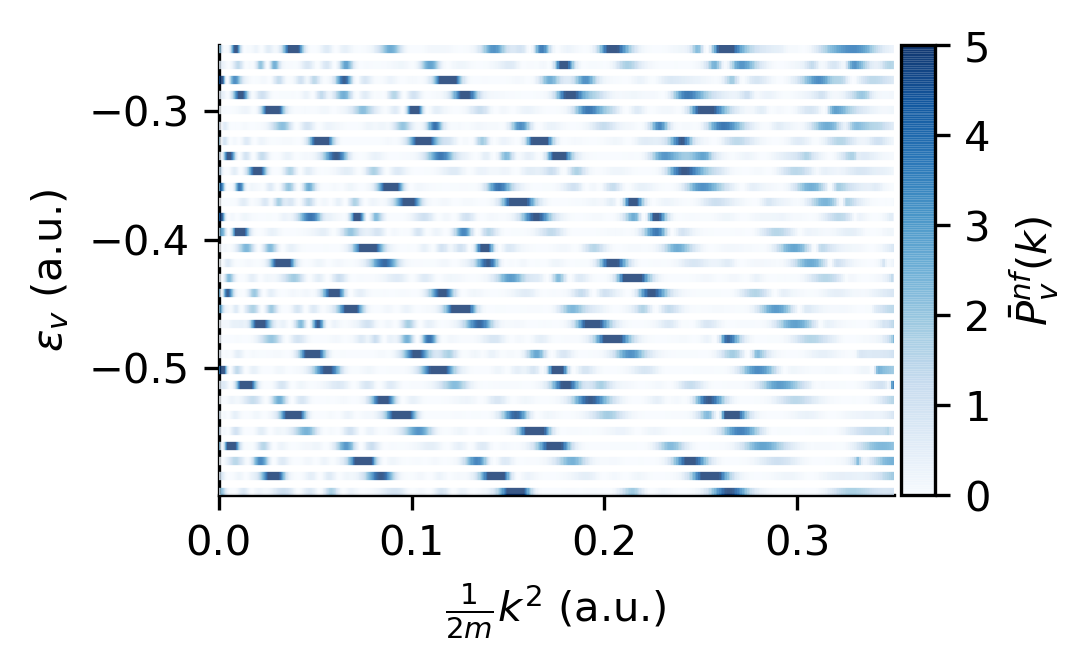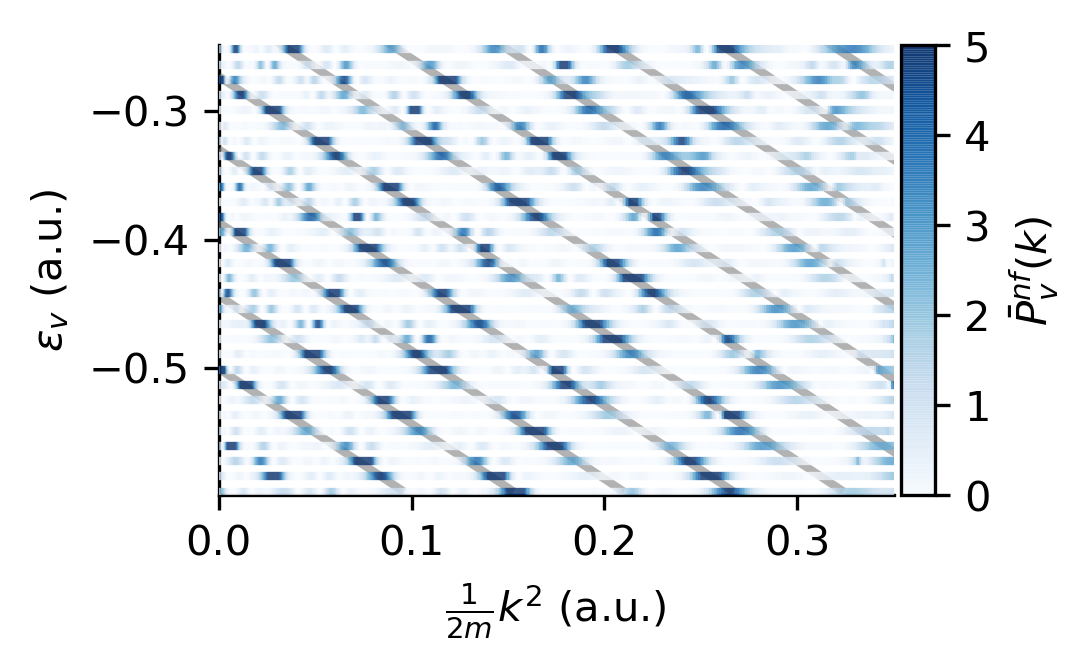Adiabatic theory of strong-field ionization of molecules including nuclear motion
Jens Svensmark
January 21, 2020
My background
Aarhus University
PhD
Kansas state university
Postdoc
University of Electro-communications (Tokyo)
Postdoc
Intro
Adiabatic theory
- Previously been used for atoms
- Here we look at molecules
Time scales
- Laser
- Motion inside molecule
- Ratio is adiabatic parameter
Adiabatic approximation
- Adiabatic parameter small
- Laser field momentarily constant
- Sequence of stationary Siegert states
Sequence of stationary states
Sequence of stationary states
Sequence of stationary states
Sequence of stationary states
Previous work
- Looked at atoms/fixed nuclei
- Electrons are fast
- Laser is slow
- How about nuclei?
PRA 86, 043417 (2012)
PRA 92, 043402 (2015)
PRL 116, 173001 (2016)
What we want to do
Extend adiabatic theory to molecules including nuclear motion
Numerical calculations
1D model
Time-dependent Schrödinger equation
Numerical methods
Split step fourier method
Scattering states found using R-matrix propagation
Fixed nuclei example
Adiabatic theory (fixed nuclei)
\(\epsilon = \frac{T_\text{e}}{T_\text{f}} \to 0\)
Photo electron momentum distribution (PEMD)
\(k:\) Momentum of outgoing electron
\(t_i\) is time at which electron with momentum \(k\) ionized, \(k = -\int_{t_i}^{\infty} F(t')dt'\)
Pulse
Adiabatic theory (fixed nuclei)
\(\epsilon = \frac{T_\text{e}}{T_\text{f}} \to 0\)
Photo electron momentum distribution (PEMD)
\(k:\) Momentum of outgoing electron
\(t_i\) is time at which electron with momentum \(k\) ionized, \(k = -\int_{t_i}^{\infty} F(t')dt'\)
\(f(F), \Gamma(F):\) Properties of Siegert state
Siegert state
Solution of time independent Schrödinger equation
with outgoing-wave boundary conditions.
Outgoing wave
Outgoing wave
Outgoing wave
Adiabatic theory (fixed nuclei)
Photo electron momentum distribution (PEMD)
\(k:\) Momentum of outgoing electron
\(t_i\) is time at which electron with momentum \(k\) ionized, \(k = -\int_{t_i}^{\infty} F(t')dt'\)
\(f(F):\) Asymptotic wave function coefficient
\(\Gamma(F):\) Total rate
Weak field limit
For \(F\to 0\) adiabatic theory reduces to Keldysh theory
Nuclear-electron interaction
Finite range potential
with \(a = 0.62772\) and \(b = 0.857\).
Gaussian half-cycle pulse
TDSE solution
Convergence to adiabatic theory
Convergence to adiabatic theory
Convergence to adiabatic theory
Including nuclear motion
Nuclear-nuclear interaction
H\(_2^+\) like interaction
with \(A=0.26, B =-0.732635\) and \(C =0.01625\)
\(R\) is the internuclear seperation
Vibrational states, molecular ion
Adiabatic theory
\(\epsilon_\text{f} = \max\left(\frac{T_\text{e}}{T_\text{f}}, \frac{T_\text{n}}{T_\text{f}}\right) \to 0\)
PEMD (for half-cycle pulse)
Total PEMD
Siegert state (real part)
PEMD
PEMD
PEMD
Slow nuclei and field (AAnf)
AAnf
\(\epsilon_\text{nf} = \max\left(\frac{T_\text{e}}{T_\text{f}}, \frac{T_\text{e}}{T_\text{n}}\right) \to 0\)
Born-Oppenheimer ansatz
Electronic Siegert state \(\psi_e(x;R,F(t))\)
where
\(H_x(F) = -\frac{1}{2}\frac{\partial^2}{\partial x^2} + Fx + V\left(x; R\right)\)
AAnf
Born-Oppenheimer ansatz
Nuclear wavefunction fulfills
Nuclear time evolution
PEMD
Build the PEMD
PEMD
PEMD
PEMD
Regions of applicability
AAf
AAnf
Regions of applicability
Compatibility
Compatibility
Compatibility
Small nuclear masses
\(T=30\) a.u.
Small nuclear masses
\(T=150\) a.u.
Few-cycle pulse
Pulse
Build the PEMD
PEMD
PEMD
Closer look at the nuclear wave function
Nuclear time evolution
Classical trajectory
Classical trajectory
Many-cycle pulse
How much time does TDSE take?
How much time does TDSE take?
PEMD
PEMD

PEMD

Many-cycle model
Similar to SFA based model in PRA 93, 031401
Inter-cycle factor
Ponderomotive energy: \(U_p = \frac{F_0^2}{4m\omega^2}\)
PEMD

Intra-cycle factor
PEMD

PEMD

Recap
- Goal: Extend adiabatic theory
- AAf only works for small nuclear masses in slow fields
- AAnf works for large nuclear masses in slow fields
- Possible next: include rescattering
- Possible next: include dissociation
Deleted scenes
Introduction
Breakdown of BOA
What we want to look at
- BOA breaks down in weak-field limit for total rate
- WFAT gives total rate
- Adiabatic theory gives differential quantities
- Differential quantities might show other BO-breakdowns
Numerical calculations
Time-independent Schrödinger equation
Scattering boundary conditions
Boundary conditions
\(\Psi_+^{\text{out}}(x,k)\)
Scattering solution method
- R-matrix propagation in \(x\)
- Adiabatic basis in \(R\) for fixed \(x\)
- Sectorized legendre DVR in \(x\)
- Sine-DVR in \(R\)
Different grids
One cycle pulse
Pulse
Build the PEMD
Full wavefunction evolution
PEMD
PEMD
PEMD
PEMD